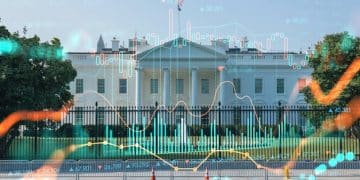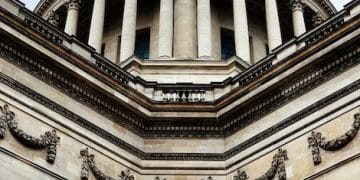Prime Rate Impact: How Lending Changes Affect US Borrowing Costs

Changes in the prime lending rate directly influence the borrowing costs for both businesses and consumers in the US, affecting interest rates on various loans such as mortgages, credit cards, and business loans, thereby impacting economic activity and financial planning.
Understanding **how do changes in the prime lending rate affect borrowing costs for businesses and consumers in the US** is key to making informed financial decisions. This article breaks down the complexities to help you navigate the financial landscape.
What is the Prime Lending Rate?
The prime lending rate is a benchmark interest rate that commercial banks use as a reference point for many types of loans they offer to businesses and consumers. It’s essentially the rate banks offer to their most creditworthy customers, and it serves as a base for other interest rates.
Understanding its mechanics and how it’s determined is crucial for anyone involved in borrowing or lending.
How the Prime Rate is Determined
The prime rate is heavily influenced by the federal funds rate, which is set by the Federal Open Market Committee (FOMC). When the FOMC raises or lowers the federal funds rate, banks typically adjust their prime rates accordingly.
- Federal Funds Rate: The target rate that the Federal Reserve wants banks to charge one another for the overnight lending of reserves.
- FOMC Decisions: The Federal Open Market Committee meets regularly to assess economic conditions and determine appropriate monetary policy.
- Market Conditions: Economic indicators like inflation, employment, and GDP growth also play a role.

In conclusion, understanding the prime lending rate is essential for anyone involved in the financial markets. Its dependence on the federal funds rate and various economic indicators make it a key indicator of economic health and borrowing conditions.
How Prime Rate Affects Business Borrowing
Businesses rely on borrowing for various reasons, from funding day-to-day operations to investing in expansion and new projects. The prime rate has a direct effect on the cost of business loans, lines of credit, and other financing options.
When the prime rate increases, it becomes more expensive for businesses to borrow money, and vice versa.
Impact on Small Businesses
Small businesses often have fewer financing options compared to larger corporations, making them particularly vulnerable to changes in the prime rate. Increased borrowing costs can squeeze their profit margins and limit their ability to invest in growth.
Higher interest rates often translate directly into reduced profitability.
Impact on Large Corporations
Large corporations typically have access to a broader range of financing options, including bonds and commercial paper. However, the prime rate can still affect their borrowing costs, particularly for short-term loans and lines of credit.
- Short-Term Loans: Commonly used for working capital and operational expenses.
- Lines of Credit: Provide flexibility for managing cash flow.
- Expansion Plans: May be delayed or scaled back due to higher borrowing costs.
In summary, the prime rate affects businesses of all sizes, influencing their borrowing costs and investment decisions. Small businesses may feel the pinch more acutely, while large corporations still need to factor in the prime rate for certain financing options.
How Prime Rate Affects Consumer Borrowing
Consumers also feel the effects of changes in the prime rate through various borrowing channels, including mortgages, credit cards, and personal loans. Understanding these effects can help individuals make more informed financial decisions.
The prime rate is a key determinant in the interest rates consumers pay on their debt.

Mortgage Rates
While mortgage rates are not directly tied to the prime rate, they are influenced by broader economic conditions, including changes in the federal funds rate, which also affects the prime rate. Adjustable-rate mortgages (ARMs) are especially sensitive to prime rate fluctuations.
Increases in the prime rate can lead to higher monthly mortgage payments for homeowners with ARMs.
Credit Card Rates
Credit card interest rates are often directly linked to the prime rate. Many credit card agreements specify that the interest rate will be a certain percentage above the prime rate. As the prime rate rises, so do credit card interest rates.
- Variable APRs: Most credit cards come with variable annual percentage rates (APRs) that fluctuate with the prime rate.
- Debt Management: Higher interest rates make it more difficult to pay down credit card debt.
- Consumer Spending: Increased borrowing costs can reduce consumer spending and economic activity.
In conclusion, changes in the prime rate have significant implications for consumer borrowing, impacting mortgage rates, credit card rates, and personal loans. Understanding these effects can help consumers manage their debt and plan their finances more effectively.
Historical Trends of the Prime Lending Rate
The prime lending rate in the United States has seen considerable fluctuations over the years, influenced by various economic events and monetary policy decisions. Examining these historical trends provides valuable context for understanding the current economic environment.
Reviewing historical data helps to gain insights into potential future rate movements.
Key Economic Events
Several major economic events have influenced the prime rate, including periods of recession, economic expansion, and monetary policy changes.
Major economic shifts often correlate with changes in the prime rate.
Impact on Economic Growth
The prime rate is closely linked to economic growth. Lower rates can stimulate borrowing and investment, leading to increased economic activity. Higher rates can cool down an overheating economy but may also slow down growth.
- Economic Stimulus: Lower rates encourage borrowing and investment.
- Inflation Control: Higher rates can help curb inflation.
- Recessions: The prime rate can be aggressively lowered during recessions to encourage economic recovery.
In summary, historical trends of the prime lending rate provide valuable insights into its relationship with economic events and growth. Understanding these trends can help businesses and consumers anticipate future rate movements and plan their finances accordingly.
Strategies for Businesses in a Changing Rate Environment
Businesses can employ several strategies to navigate the challenges and opportunities presented by a changing prime rate environment. These strategies involve proactive financial planning, risk management, and diversification of funding sources.
Adapting to rate changes is key to maintaining financial stability.
Risk Management
Risk management is crucial in a changing rate environment. Businesses should assess their exposure to interest rate fluctuations and implement strategies to mitigate these risks.
Diversification of Funding Sources
Relying solely on bank loans can make businesses vulnerable to prime rate fluctuations. Diversifying funding sources can provide more flexibility and reduce risk.
- Bonds: Issuing corporate bonds can provide fixed-rate financing.
- Equity Financing: Raising capital through equity can reduce reliance on debt.
- Government Programs: Utilizing government-backed loan programs can offer favorable terms.
In conclusion, businesses can navigate a changing rate environment by implementing proactive financial planning, effective risk management strategies, and diversification of funding sources. These measures can help businesses maintain financial stability and capitalize on opportunities, regardless of rate fluctuations.
Strategies for Consumers in a Changing Rate Environment
Consumers can take proactive steps to manage the impact of changing prime rates on their finances. These strategies include managing debt, refinancing options, and adjusting spending habits.
Proactive management helps consumers mitigate the impacts of rate changes.
Debt Management
Managing debt is crucial in a rising rate environment. Prioritizing high-interest debt, such as credit card balances, can save consumers money in the long run.
Lowering overall debt can significantly reduce the impact of rising interest rates.
Refinancing Options
Refinancing existing loans, such as mortgages and auto loans, can be a viable option when interest rates are low or expected to rise further. Refinancing can help consumers lock in lower rates and reduce their monthly payments.
- Mortgage Refinancing: Can lower monthly payments and save money over the life of the loan.
- Auto Loan Refinancing: Similar benefits to mortgage refinancing.
- Debt Consolidation: Combining multiple debts into a single loan with a lower interest rate.
In summary, consumers can mitigate the impact of changing prime rates by actively managing their debt, exploring refinancing options, and adjusting their spending habits. Taking these steps can help consumers maintain their financial stability and achieve their financial goals, regardless of rate fluctuations.
| Key Point | Brief Description |
|---|---|
| 💰 Prime Rate Definition | Benchmark rate banks use for loans to creditworthy customers. |
| 📈 Business Impact | Affects loan costs, investments, and operational planning. |
| 💳 Consumer Effects | Influences mortgage, credit card, and personal loan rates. |
| 🏦 Fed’s Role | Federal Reserve influences the prime rate via the federal funds rate. |
Frequently Asked Questions
▼
The prime rate can change multiple times a year, depending on the Federal Reserve’s monetary policy and overall economic conditions. There is no set schedule for adjustments.
▼
Most credit cards have variable interest rates tied to the prime rate, but some may have fixed rates or rates tied to other benchmarks. Check your card agreement for details.
▼
Small businesses should maintain healthy cash reserves, diversify funding sources, and assess their exposure to interest rate risk. Consider fixed-rate loans where possible.
▼
The federal funds rate is the target rate set by the Federal Reserve for overnight lending between banks. The prime rate is the rate that commercial banks charge their most creditworthy customers, influenced by the fed funds rate.
▼
It depends on your current mortgage rate and the prevailing rates. If you have an adjustable-rate mortgage and rates are rising, refinancing to a fixed-rate loan may be beneficial. Consult with a financial advisor.
Conclusion
Understanding how changes in the prime lending rate affect borrowing costs is crucial for both businesses and consumers in the US. By staying informed and proactive, businesses and individuals can mitigate risks and seize opportunities in a dynamic financial landscape.





